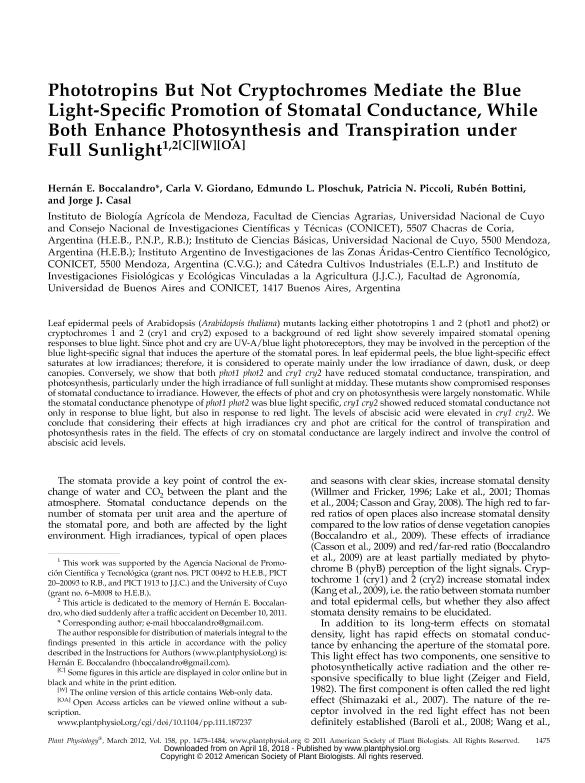Mostrar el registro sencillo del ítem
dc.contributor.author
Boccalandro, Hernan Esteban

dc.contributor.author
Giordano, Carla Valeria

dc.contributor.author
Ploschuk, Edmundo Leonardo

dc.contributor.author
Piccoli, Patricia Noemí

dc.contributor.author
Bottini, Ambrosio Rubén

dc.contributor.author
Casal, Jorge José

dc.date.available
2018-04-18T14:19:38Z
dc.date.issued
2011-12
dc.identifier.citation
Boccalandro, Hernan Esteban; Giordano, Carla Valeria; Ploschuk, Edmundo Leonardo; Piccoli, Patricia Noemí; Bottini, Ambrosio Rubén; et al.; Phototropins But Not Cryptochromes Mediate the Blue Light-Specific Promotion of Stomatal Conductance, While Both Enhance Photosynthesis and Transpiration under Full Sunlight; American Society of Plant Biologist; Plant Physiology; 158; 3; 12-2011; 1475-1484
dc.identifier.issn
0032-0889
dc.identifier.uri
http://hdl.handle.net/11336/42438
dc.description.abstract
Leaf epidermal peels of Arabidopsis (Arabidopsis thaliana) mutants lacking either phototropins 1 and 2 (phot1 and phot2) or cryptochromes 1 and 2 (cry1 and cry2) exposed to a background of red light show severely impaired stomatal opening responses to blue light. Since phot and cry are UV-A/blue light photoreceptors, they may be involved in the perception of the blue light-specific signal that induces the aperture of the stomatal pores. In leaf epidermal peels, the blue light-specific effect saturates at low irradiances; therefore, it is considered to operate mainly under the low irradiance of dawn, dusk, or deep canopies. Conversely, we show that bothphot1 phot2andcry1 cry2have reduced stomatal conductance, transpiration, and photosynthesis, particularly under the high irradiance of full sunlight at midday. These mutants show compromised responses of stomatal conductance to irradiance. However, the effects of phot and cry on photosynthesis were largely nonstomatic. While the stomatal conductance phenotype ofphot1 phot2was blue light specific,cry1 cry2showed reduced stomatal conductance not only in response to blue light, but also in response to red light. The levels of abscisic acid were elevated incry1 cry2. We conclude that considering their effects at high irradiances cry and phot are critical for the control of transpiration and photosynthesis rates in the field. The effects of cry on stomatal conductance are largely indirect and involve the control of abscisic acid levels.
dc.format
application/pdf
dc.language.iso
eng
dc.publisher
American Society of Plant Biologist

dc.rights
info:eu-repo/semantics/openAccess
dc.rights.uri
https://creativecommons.org/licenses/by-nc-sa/2.5/ar/
dc.subject
Stomata
dc.subject
Phototropin
dc.subject
Cryptochrome
dc.subject
Aba
dc.subject.classification
Otras Ciencias Biológicas

dc.subject.classification
Ciencias Biológicas

dc.subject.classification
CIENCIAS NATURALES Y EXACTAS

dc.title
Phototropins But Not Cryptochromes Mediate the Blue Light-Specific Promotion of Stomatal Conductance, While Both Enhance Photosynthesis and Transpiration under Full Sunlight
dc.type
info:eu-repo/semantics/article
dc.type
info:ar-repo/semantics/artículo
dc.type
info:eu-repo/semantics/publishedVersion
dc.date.updated
2018-04-05T18:24:29Z
dc.journal.volume
158
dc.journal.number
3
dc.journal.pagination
1475-1484
dc.journal.pais
Estados Unidos

dc.journal.ciudad
Rockville
dc.description.fil
Fil: Boccalandro, Hernan Esteban. Consejo Nacional de Investigaciones Científicas y Técnicas. Centro Científico Tecnológico Conicet - Mendoza. Instituto de Biología Agrícola de Mendoza. Universidad Nacional de Cuyo. Facultad de Ciencias Agrarias. Instituto de Biología Agrícola de Mendoza; Argentina
dc.description.fil
Fil: Giordano, Carla Valeria. Consejo Nacional de Investigaciones Científicas y Técnicas. Centro Científico Tecnológico Conicet - Mendoza. Instituto Argentino de Investigaciones de las Zonas Áridas. Provincia de Mendoza. Instituto Argentino de Investigaciones de las Zonas Áridas. Universidad Nacional de Cuyo. Instituto Argentino de Investigaciones de las Zonas Áridas; Argentina
dc.description.fil
Fil: Ploschuk, Edmundo Leonardo. Universidad de Buenos Aires. Facultad de Agronomía; Argentina
dc.description.fil
Fil: Piccoli, Patricia Noemí. Consejo Nacional de Investigaciones Científicas y Técnicas. Centro Científico Tecnológico Conicet - Mendoza. Instituto de Biología Agrícola de Mendoza. Universidad Nacional de Cuyo. Facultad de Ciencias Agrarias. Instituto de Biología Agrícola de Mendoza; Argentina
dc.description.fil
Fil: Bottini, Ambrosio Rubén. Consejo Nacional de Investigaciones Científicas y Técnicas. Centro Científico Tecnológico Conicet - Mendoza. Instituto de Biología Agrícola de Mendoza. Universidad Nacional de Cuyo. Facultad de Ciencias Agrarias. Instituto de Biología Agrícola de Mendoza; Argentina
dc.description.fil
Fil: Casal, Jorge José. Consejo Nacional de Investigaciones Científicas y Técnicas. Oficina de Coordinación Administrativa Parque Centenario. Instituto de Investigaciones Fisiológicas y Ecológicas Vinculadas a la Agricultura. Universidad de Buenos Aires. Facultad de Agronomía. Instituto de Investigaciones Fisiológicas y Ecológicas Vinculadas a la Agricultura; Argentina
dc.journal.title
Plant Physiology

dc.relation.alternativeid
info:eu-repo/semantics/altIdentifier/doi/http://dx.doi.org/10.1104/pp.111.187237
dc.relation.alternativeid
info:eu-repo/semantics/altIdentifier/url/http://www.plantphysiol.org/content/158/3/1475
Archivos asociados
